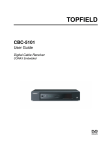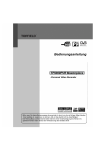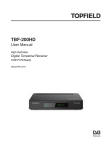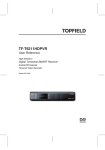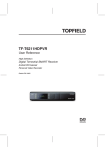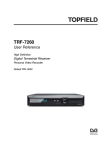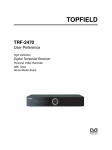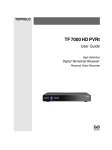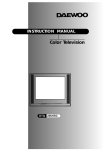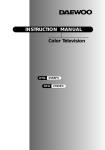Download User guide for TBF-7110
Transcript
TBF - 7110 User Guide High Definition Digital Terrestrial Receiver The lightning flash with arrowhead symbol, within an equilateral triangle, is intended to alert the user to the presence of uninsulated “dangerous voltage” within the product’s enclosure that may be of sufficient magnitude to constitute a risk of electric shock to a person. The exclamation point, within an equilateral triangle, is intended to alert the user to the presence of important operating and maintenance (servicing) instructions in the literature accompanying the product. iv CONTENTS Contents Contents 1 2 3 Introduction 1.1 Features . . . . . . . . . . . . . 1.2 Controlling the digital receiver 1.2.1 The front panel . . . . . 1.2.2 The remote control . . . iv . . . . . . . . . . . . . . . . . . . . . . . . . . . . . . . . . . . . . . . . . . . . . . . . . . . . 1 1 2 3 4 Setup 2.1 Unpacking . . . . . . . . . . . . . . . . . . 2.2 Safety precautions . . . . . . . . . . . . . 2.3 Rear panel connections . . . . . . . . . . . 2.4 Connecting up your digital receiver . . . 2.4.1 Connecting the antenna . . . . . . 2.4.2 Connecting to your television set 2.5 Inserting batteries in the remote control . 2.6 Switching on for the first time . . . . . . . 2.6.1 Powering on and checking picture . . . . . . . . . . . . . . . . . . . . . . . . . . . . . . . . . . . . . . . . . . . . . . . . . . . . . . . . . . . . . . . . . . . . . . . . . . . . . . . . . . . . . . . . . . . . . . . . . . . . . . . . . . . . 6 6 6 8 9 9 10 12 12 12 Preference Settings 3.1 Language settings . . . . . . . . . 3.2 Video and audio settings . . . . . 3.2.1 Television aspect ratio . . 3.2.2 High definition television 3.2.3 Audio mode . . . . . . . . . . . . . . . . . . . . . . . . . . . . . . . . . . . . . . . . . . . . . . . . . . . . . . . . . . . . . . . . . . . 13 13 14 14 16 16 . . . . . . . . . . . . . . . . . . . . . . . . . . . . . . . . . . . . . . . . . . . . . CONTENTS 3.3 3.4 3.5 3.6 Local time setting . . . . . . . . . . . . Parental control . . . . . . . . . . . . . Adjusting the On-Screen Display . . . Displaying the time in standby mode . . . . . . . . . . . . . . . . . . . . . . . . . . . . . . . . . . . . . . . . . . . . . . . . . . . . . . . . v 17 19 21 21 4 Service Search 22 4.1 Searching broadcasting services . . . . . . . . . . . . . . . . . . 22 4.2 Resetting to factory settings . . . . . . . . . . . . . . . . . . . . 23 5 Daily Usage 5.1 Volume control . . . . . . . . . . . . . . . 5.2 Watching television . . . . . . . . . . . . . 5.2.1 The services list . . . . . . . . . . . 5.2.2 The favourite services list . . . . . 5.2.3 Viewing programme information 5.2.4 Selecting audio tracks . . . . . . . 5.2.5 Selecting subtitle tracks . . . . . . 5.2.6 Viewing teletext . . . . . . . . . . 5.3 Viewing electronic programme guide . . 5.4 Making timer events . . . . . . . . . . . . . . . . . . . . . . . . . . . . . . . . . . . . . . . . . . . . . . . . . . . . . . . . . . . . . . . . . . . . . . . . . . . . . . . . . . . . . . . . . . . . . . . . . . . . . . . . . . . . . . . . . . . . . . . . . . . . . . . . . . . . 24 24 24 24 26 27 27 28 28 28 30 6 Listing Services 32 6.1 Editing the favourite list . . . . . . . . . . . . . . . . . . . . . . 32 6.2 How to use on-screen keyboard . . . . . . . . . . . . . . . . . . 34 7 Firmware Update 7.1 Checking the firmware information . . . . . . . . . . . . . . . 7.2 From a USB memory . . . . . . . . . . . . . . . . . . . . . . . . 7.3 From your computer via RS-232 port . . . . . . . . . . . . . . . Index 35 35 36 37 38 1 Chapter 1 Introduction The TBF - 7110 digital receiver is fully compliant with the international Digital Video Broadcasting (DVB) standard, and thus is able to receive digital broadcasts of that standard. For its operation you need an antenna, which must be installed appropriately. NOTE In general we equate a channel with a frequency. However, unlike analogue broadcasts, digital broadcasts are not all assigned to their own frequencies; instead, multiple television broadcasts are transmitted through a single frequency. The frequency in digital broadcasting is usually called transponder. To reduce confusion in this manual, the word service is preferably used than channel as a term to indicate one television or radio broadcast. 1.1 Features The TBF - 7110 digital receiver has the following features: 2 Introduction • Supports the Australian Freeview Phase 1. • Can store up to 2000 television and radio services. • Can create favourite lists of your favourite services. • Can view information about the current television or radio programme. • Has an electronic programme guide that provides an overview of scheduled programmes. 1.2 Controlling the digital receiver You can operate the digital receiver with the remote control or the buttons on the front panel. NOTE When the digital receiver is off but plugged into a wall outlet, we say that it is in standby mode; on the other hand, when it is on, it is in operation mode. Even when you are not using the digital receiver, you should keep it plugged into a wall outlet to be in standby mode so that it can run timer events at any time. 1.2 Controlling the digital receiver 1.2.1 3 The front panel The front panel of the digital receiver has buttons to control the digital receiver, specific lamps and a display to indicate its status. The following indicates what they mean. STANDBY button switches the digital receiver between standby mode and operation mode. ca CHANNEL , buttons switch to previous or next service. They are also used to navigate in menus and interactive screens. lamp blinks whenever you press a button on the remote control. STANDBY lamp lights up while the digital receiver is in standby mode. Front display shows the current time in standby mode, and displays the current service in operation mode. 4 Introduction 1.2.2 The remote control 1 button switches the digital receiver between standby mode and operation mode. 2 is used to set a sleep timer in 10 minute increments. 4 18 16 1 14 15 7 6 10 12 11 2 13 19 5 17 3 3 8 5 9 4 mutes the sound. Press again to switch it back on. 20 5 P− , P+ buttons switch to previous or next service. They are also used to navigate in menus and interactive screens. 6 21 3 V− , V+ buttons decrease or increase the volume. They are also used to change values for menu options. switches between the current service and the previously viewed one. 7 Numeric buttons are used to enter a service number for service change or to specify values for menu options. 8 OK displays the services list. See § 5.2.1 for more details. It is also used to select a menu item. 9 FAV displays the favourite lists. 10 displays the service information box. It is also used to display more information about a programme. 11 is used to select an audio track and a sound mode, or 1.2 Controlling the digital receiver 5 a video track of multifeed programme. 12 is used to select a subtitle track. 13 displays teletext. 14 V.Format changes video resolution. See § 3.2.2 for more details. 15 16 pauses live television. switches between television services and radio services. 17 GUIDE displays the electronic programme guide. 18 A/R changes aspect ratio. See § 3.2.1 for more details. 19 MENU displays the main menu. It is also used to return to the previous menu from a submenu. 20 EXIT is used to exit a menu or to hide on-screen info. 21 These buttons have different functions per menu. They will be guided by on-screen help. 6 Setup Chapter 2 Setup 2.1 Unpacking Before going any further, check that you have received the following items with your digital receiver. • Remote control unit • Two batteries for the remote control (AAA 1.5 V) • One component cable (RCA cable) • One composite cable (RCA cable) • A copy of this user guide NOTE Accessories may vary according to your local area. 2.2 Safety precautions Please read carefully the following safety precautions. 2.2 Safety precautions 7 • The mains power must be 90 to 250 volts. Check it before connecting the digital receiver to the mains socket. For the power consumption of the digital receiver, refer to Table 2.1. • The mains outlet should be near the equipment. Do not run an extension lead to the unit. • Do not expose the digital receiver to any moisture. The digital receiver is designed for use indoors only. Use dry cloth when cleaning the digital receiver. • Place the digital receiver on a firm and level surface. • Do not place the digital receiver close to heat emitting units or in direct sunlight, as this will impair cooling. Do not lay any objects such as magazines on the digital receiver. When placed in a cabinet, make sure there is a minimum space of 10 centimetres around it. For the physical specification of the digital receiver, refer to Table 2.2. • Protect the power cord from being walked on or pinched. If the cord is damaged, do not use the digital receiver and get the cord replaced. • Never open the digital receiver casing under any circumstances, the warranty will be void. • Refer all servicing to a qualified service technician. Table 2.1: Power specifications Input voltage Power consumption 90 to 250 V AC, 50/60 Hz 20 W at maximum in operation 1 W in passive standby (MEPS compliant) 8 Setup Table 2.2: Physical specifications Size Weight Operating temperature Storage relative humidity 2.3 260× 46× 190 mm 1.2 kg 0 to 45 °C 5 to 90 % Rear panel connections The TBF - 7110 has the following connections on the back. Check what connections your television set has in comparison with the digital receiver. 1 ANT IN Terrestrial broadcasting signal input socket. 2 ANT OUT Terrestrial broadcasting signal output socket through the ANT IN socket for another digital receiver. 3 USB USB port for firmware update and data transfer. 4 HDMI Audio and video output socket for the high definition television set. 5 Y/Pb/Pr Component video output socket for the television set. (green/blue/red) 6 AUDIO L/R Stereo audio output socket for the television set or the audio system. (white/red) 2.4 Connecting up your digital receiver 9 7 VIDEO Composite video output socket for the television set. (yellow) 8 S/PDIF Dolby digital output socket for the audio system. 9 RS-232 Serial port for firmware update and data transfer. Table 2.3: Connectors specifications HDMI VIDEO AUDIO YPbPr S/PDIF RS-232 2.4 High definition video output Left & right audio output Dolby Digital audio output Composite video (CVBS) output Left & right audio output Component video (YUV) output Dolby digital audio output 115.2 kbps at maximum Connecting up your digital receiver There are several ways to set up the digital receiver. Set up the digital receiver suitably to your television and other appliances. If you have any problem with your setup or need help, contact your dealer. 2.4.1 Connecting the antenna Whatever sort of connection you have between the digital receiver and the television, you need to connect the digital receiver to your television antenna so that it can receive digital television services. Connect the antenna cable to the ANT IN connector. If you have another digital receiver, you may link the ANT OUT connector to your television. 10 Setup 2.4.2 Connecting to your television set For all the following connections of the digital receiver, we recommend you use the first connector to get the best picture quality. If your television does not have a matching connector, then use the next connector in the following order for a better picture quality. 1. HDMI connector (HDMI) 2. Component connector (YPbPr) 3. Composite connector (VIDEO) You should configure audio and video settings after connecting up the digital receiver. See § 3.2 for a detailed description. To use the HDMI connector If you have a high definition television set, you should use a HDMI cable for best results. Plug one end of the cable into the HDMI socket on the digital receiver, and plug the other end into the matching socket on your television. In this case, you do not have to make audio connection because the HDMI connector can output stereo audio or Dolby digital audio. To use the component video connector You need to obtain a component video cable (RCA cable) to use the component video connector. Plug one ends of the cable into the Y (green), Pb (blue) and Pr (red) sockets on the digital receiver, and plug the other ends into the matching sockets on your television. 2.4 Connecting up your digital receiver 11 To use the composite video connector NOTE You cannot view high definition video with a composite video connector. You need to obtain a composite video cable (RCA cable) to use the composite video connector. Plug one end of the cable into the VIDEO (yellow) socket on the digital receiver, and plug the other end into the matching socket on your television. To make the audio connection You need to obtain an audio cable (RCA cable) to connect the audio connectors. Plug one end of the cable into the AUDIO L (white) and AUDIO R (red) sockets on the digital receiver, and plug the other end into the matching sockets on your television or audio system. To enjoy Dolby digital audio, your television or audio system must be able to decode Dolby digital audio, and you need to obtain a S/PDIF cable. Plug one end of the cable into the S/PDIF socket on the digital receiver, and plug the other end into the matching socket on your audio system. 12 Setup 2.5 Inserting batteries in the remote control Open the battery compartment by removing the lid, and then insert the batteries observing the polarity, which is marked on the base of the battery compartment. If the digital receiver no longer reacts properly to remote control commands, the batteries may be flat. Be sure to remove used batteries. The manufacturer accepts no liability for the damage resulting from leaking batteries. NOTE Batteries, including those which contain no heavy metals, may not be disposed with other household wastes. Please dispose of used batteries in an environmentally sound manner. Find out the legal regulations which apply in your area. 2.6 Switching on for the first time Now that you have your digital receiver connected, you should plug it into a mains socket. Ensure that your television set is turned on and on the correct AV channel, so that you will be able to see the display from the digital receiver. 2.6.1 Powering on and checking picture Press the button in top left corner on the remote control. After about 10 seconds you may see a picture displaying a menu. If you do not see a picture, try pressing the V.Format button on the remote control. If after several tries you still get no picture, check that the television is set to the correct input. If the picture is good, you can skip to § 4.1 to search for the available television and radio services. Otherwise, you may need to temporarily connect the composite video connector (VIDEO) to your television set so that you can see the on-screen menus in order to configure the video settings. 13 Chapter 3 Preference Settings 3.1 Language settings You can select the language of audio track and of subtitle track. Select the System Setting > Language Setting menu. You should see a screen like the left figure. Subtitle language Set the 1st Subtitle Language option and the 2nd Subtitle Language option to your desired languages. When you watch a programme, if the programme has a subtitle track of the language that is designated for the 1st Subtitle Language, it will be displayed. If the first language is not available but the second language is available, the subtitle of the second language will 14 Preference Settings be displayed. If there is no available language, no subtitle will be displayed. Apart from this setting, you can select a subtitle track with the button. See § 5.2.5 for a detailed description. Audio language Set the 1st Audio Language option and the 2nd Audio Language option to your desired languages. When you watch a programme, if the programme has an audio track of the language that is designated for the 1st Audio Language, it will be outputted. If the first language is not available but the second language is, the audio of the second language will be outputted. Apart from this setting, you can select an audio track with the button. See § 5.2.4 for a detailed description. 3.2 Video and audio settings You have to configure the video and audio settings appropriately for your television set and other appliances. Select the System Setting > A/V Output Setting menu. You should see a screen like the left figure. 3.2.1 Television aspect ratio If you have a wide-screen television, set the TV Aspect Ratio option to 16:9. 3.2 Video and audio settings 15 You can enjoy both wide-screen programmes and normalscreen programmes with your wide-screen television as the above figures show. To watch normal-screen programmes in full screen like the left figure, set the 4:3 Display Format option to Full. Normal-screen pictures then will be inflated to fit to the width of the wide screen. Otherwise, to watch them in the original ratio like the right figure, set it to Center. Otherwise, if you have a normal-screen television, set the TV Aspect Ratio option to 4:3. You cannot fully enjoy wide-screen programmes with your normal-screen television as the above figures show. The left figure shows a normal picture displayed in the normal screen. To watch wide-screen programmes in the shape like the centre figure, set the 16:9 Display Format option to Letter Box. Widescreen pictures then will be reduced to fit to the width of the normal screen. Otherwise, to watch them in the shape like the right figure, set it to Center extract. Then wide-screen pictures will be cut out on the left and right sides equally to fit to the width of the normal screen. 16 Preference Settings 3.2.2 High definition television The digital receiver supports various video resolutions from 576 to 1080. In general a resolution of 720 or more is considered high definition. The higher the resolution, the better the quality. However, if your television set does not support high definition, you cannot enjoy high definition quality picture. Set the Video Format option as you desire. If you set this option to 576P, the digital receiver will present even high definition programmes in resolution of 576. On the contrary, if you set it to 1080I, the digital receiver will present even standard definition programmes in resolution of 1080. It is recommended to set it to Auto if you have a high definition television. With that setting the digital receiver will present a programme as it is without any resolution conversion. While watching television you can change the resolution with the V.Format button. Whenever you press it, the video resolution is changed in turn. NOTE You can enjoy only standard definition video with the following connector: • Composite video connector (VIDEO) 3.2.3 Audio mode Basically, there are two audio sources as you can find two audio sockets on the back panel of the digital receiver. You can enjoy only one source or both of them in either stereo or mono. Set the Sound Mode option as you desire. Apart from this setting, you can change the sound mode with the button. See § 5.2.4 for a detailed description. The digital receiver can output two types of digital audio signals via the S/PDIF connector. One is an encoded signal, and 3.3 Local time setting 17 the other is a decoded signal. If your digital audio system does not have a Dolby Digital decoder, you have to set the Dolby Output option to PCM. Otherwise, set it to Bitstream. NOTE If the service you are currently watching does not provide Dolby digital, you cannot watch the programme with Dolby sound even though you set the Dolby Output option to Bitstream. If the service you are watching provides Dolby digital, the Dolby sound could be low. If so, set the DRC Type option to RF Mode to increase the sound. 3.3 Local time setting You should set your local time for timer events. Select the System Setting > Time Setting menu. You should see a screen like the left figure. You can set the clock manually or use the time signal, Greenwich Mean Time (GMT), carried as part of the digital television broadcast. To use Greenwich Mean Time, take the following steps: 1. Set the Mode option to Auto; then the Time Offset option becomes enabled. 2. Set the Time Offset option to the time difference between your time zone and GMT referring to Table 3.1. 3. Make sure that your local time is correctly displayed on the Local Time option. 18 Preference Settings Table 3.1: Time offset table Time offset City GMT − 12:00 GMT − 11:00 GMT − 10:00 GMT − 09:00 GMT − 08:00 GMT − 07:00 GMT − 06:00 GMT − 05:00 GMT − 04:00 GMT − 03:30 GMT − 03:00 GMT − 02:00 GMT − 01:00 GMT GMT + 1:00 GMT + 2:00 GMT + 3:00 GMT + 3:30 GMT + 4:00 GMT + 4:30 GMT + 5:00 GMT + 5:30 GMT + 6:00 GMT + 7:00 GMT + 8:00 GMT + 9:00 GMT + 9:30 GMT + 10:00 GMT + 11:00 GMT + 12:00 Eniwetok, Kwajalein Midway Island, Samoa Hawaii Alaska Pacific Time US, Canada Mountain Time US, Canada Central Time US, Canada, Mexico City Eastern Time US, Canada, Bogota, Lima Atlantic Time Canada, La Paz Newfoundland Brazil, Georgetown, Buenos Aries Mid-Atlantic Azores, Cape Verde Islands London, Lisbon, Casablanca Paris, Brussels, Copenhagen, Madrid South Africa, Kaliningrad Baghdad, Riyadh, Moscow, St. Petersburg Tehran Abu Dhabi, Muscat, Baku, Tbilisi Kabul Ekaterinburg, Islamabad, Karachi, Tashkent Bombay, Calcutta, Madras, New Delhi Almaty, Dhaka, Colombo Bangkok, Hanoi, Jakarta Beijing, Perth, Singapore, Hong Kong Tokyo, Seoul, Osaka, Sapporo, Yakutsk Adelaide, Darwin Eastern Australia, Guam, Vladivostok Magadan, Solomon Islands, New Caledonia Fiji, Auckland, Wellington, Kamchatka To set the local time manually, set the Mode option to Manual and enter your local time to the Local Time option with the numeric buttons. The time format is day/month/year 24hour:minute. If daylight saving time is observed in your state at the moment, set the Daylight Saving Time option to On. 3.4 Parental control 19 NOTE Daylight saving time adds one hour to the time when the option is set to On. When setting the time offset from Greenwich Mean Time, make sure that time offset does not include daylight saving time. 3.4 Parental control In general, television programmes are classified according to the level of violence, nudity and language of their content. When you are watching a programme, you can check its programme classification on the information box. For the information box, see § 5.2.3. You can prevent your children from watching specific programmes by specifying a programme classification. Select the System Setting > Parental Control menu. You should see a screen like the left figure, and you will be asked your Personal Identification Number (PIN). The number is initially set to ‘0000’ as a default. To block programmes with undesired content for family viewing, set the Censorship option to your desired level among the following: No block restricts no prorgramme. Total block restricts every programme, even those with no programme classification. 20 Preference Settings G restricts to G or above. G rated programmes are suitable for all audiences. PG restricts to PG or above rated programmes. PG stands for Parental Guidance, the content of which is mild. M restricts to M or above rated programmes. M stands for Mature, the content of which is moderate in impact. MA restricts to MA or above rated programmes. MA stands for Mature Audiance, the content of which is strong. R restricts to R rated programmes. R stands for Restricted to adults aged 18 years or over, the content of which is very strong. AV restricts to AV rated programmes. AV stands for Adult Viewing, the content of which is deep hardcore. NOTE If a programme does not have any programme classification information, your censorship setting will not take effect. If anyone is trying to watch a programme that is of or above the censorship setting, the person has to enter the personal identification number to override. To change the number, select the Change PIN Code menu; then an input box appears. You have to enter a desired number twice for confirmation. You can also restrict uses of some menus. Selecting the Access Control menu displays a list of menus that you can lock. If the Time Setting item is set to Locked, you have to enter the personal identification number when accessing the Time Setting menu. If you enter a wrong number, you cannot use the menu. To release a shut item, set it to Unlocked. 3.5 Adjusting the On-Screen Display 3.5 21 Adjusting the On-Screen Display You can adjust the transparency level of the On-Screen Display (OSD). Select the System Setting menu and set the OSD Transparency option as you desire. Its available range is 0 to 50 percent. You can adjust the display time of the information box. For the information box, see § 5.2.3. To adjust its display time, select the System Setting menu and set the Info Box Display Time option as you desire. Its available range is 1 to 30 seconds. If you set this option to No Info Box, the information box will not be displayed when you switch services. However, pressing the button will display the information box. If you set this option to Never Hide, the information box will always be displayed. In addition, you can raise or lower the position of the information box. Select the System Setting menu and set the Info Box Position option as you desire. Its available range is −10 to +3 lines. The higher you set the option, the lower the information box will be positioned. 3.6 Displaying the time in standby mode You can display the current time on the front display in standby mode. To display the time, select the System Setting menu and set the Standby Mode option to Active standby. Otherwise, set it to Passive standby. When you set the Standby Mode option to Active standby, the receiver can also bypass the signal from the antenna. 22 Service Search Chapter 4 Service Search After connecting up the digital receiver, you will need to perform a service search. 4.1 Searching broadcasting services To perform service search, select the Installation > Service Search menu. You should see a screen like the left figure. You should set the Search Mode option to Auto for the first time after connecting up the digital receiver; then the digital receiver will search for all available services. You may choose to only search for services of a specific transponder because more than one service are provided via each 4.2 Resetting to factory settings 23 transponder. To do that, set the Search Mode option to Manual, and then at the Channel option select your desired transponder. The number ranges from 6 to 12 in VHF and 28 to 69 in UHF. To search one service of a transponder, set the Search Mode option to Advanced, and at the PID option specify the PIDs of your desired service with the numeric buttons. PID (Packet Identifier) is a set of numbers that identifies transport stream packets. To start service search, select the Start Search item; then a list box appears, in which found services will be listed. When it has completed, press the OK button to save found services. To stop at any time or to exit without saving, press the EXIT button. 4.2 Resetting to factory settings The digital receiver maintains the following data: • • • • Services list Favourite list Timer list Preference settings You can reset all data of the digital receiver. To do that, select the Installation > Factory Setting menu, and then you get asked for confirmation. If you select Yes, service entries, favourite entries and timer events will all be deleted, and preference options will be reset to the manufacturer’s factory settings. 24 Daily Usage Chapter 5 Daily Usage 5.1 Volume control Use the V− and V+ buttons to alter the volume to a comfortable level. You may need to adjust the volume on your television set too. To temporarily switch off the sound, press the button. Press it again to restore the sound to previous level. 5.2 Watching television To change services, press the P+ or P− button. Pressing the button switches to the previously viewed service. In addition, you can switch to your desired service by entering its service number with the numeric buttons. You can also select a service to watch in the services list. 5.2.1 The services list To view the services list, press the OK button. 5.2 Watching television 25 On the services list, you can see the service information as follows: • Service number and name • Transponder information To select a desired service, put the highlight bar on its entry with the P+ or P− button and press the OK button; then the service will be displayed. Pressing the V− or V+ button skips over 10 entries up or down. Entering a service number with the numeric buttons puts the highlight bar on its entry. You can switch between the television services list and the radio services list by pressing the button. Pressing the F4 button displays the additional options, with which you can do the following: • By setting the Show Provider option to On, you can view service entries by groups of broadcasters. • To change the name of the highlighted service, select the Rename option; then the on-screen keyboard appears, with which you can enter a new name. See § 6.2 for how to use the on-screen keyboard. • You can prevent other family members from watching the highlighted service by setting the Lock option to Locked. You have to enter your personal identification number to watch or unlock it. • To add the highlighted service into a favourite group, select the Add to Fav option; then the favourite groups 26 Daily Usage will be displayed. Put the highlight bar on a desired group and press the OK button. 5.2.2 The favourite services list You can select a service to watch on a favourite list as well as on the services list. To display the favourite lists, press the FAV button. You should see a screen like the left figure. As you move the highlight bar up or down on the favourite group list at the left box, favourite services belonging to the highlighted group are listed on the right box. For how to edit the favourite lists, refer to § 6.1. To select a favourite service, put the hightlight bar on a desired group and press the V+ button; a highlight bar appears on its favourite services list. Once you select a desired service with the OK button, it will be presented. Otherwise, to select other group, press the V− button. After you have selected a favourite service, if you then switch to another service using the P+ or P− button, it will be also another favourite service of the selected group. The digital receiver will remind you what group you have selected by displaying its name at the top right of the screen whenever you switch services. If you wish to get out of the current group, select the All services group on the favourite group list. Besides that, you can add or delete a favourite group or service. To add a service you are currently watching into a favourite group, put the highlight bar on a desired group and press the F3 button. To create a new group, press the F2 button; then 5.2 Watching television 27 the on-screen keyboard appears. Enter your desired name and save it. See § 6.2 for how to use the on-screen keyboard. To delete a group or a service, press the F4 button; then you get asked for confirmation. If you select Yes, it will be deleted. 5.2.3 Viewing programme information Pressing the button displays the information box, on which you can see all of the following: • • • • • • • Service number and name Signal level and quality Programme name Programme classification symbol Programme summary Broadcasting time Current time In addition, you might see the following symbols: • Subtitle symbol ( ) if subtitle tracks are provided on the current programme. • Teletext symbol ( current service. ) if teletext pages are provided on the • Dolby symbol ( ) if a Dolby audio track is provided on the current programme. Pressing the button once more displays detailed information about the current programme. To hide the information box, press the EXIT button. 5.2.4 Selecting audio tracks Some programmes are provided with audio tracks in one or button displays available more languages. Pressing the 28 Daily Usage audio tracks. Once you select an audio track, that track will be heard. In addition, you can enjoy audio tracks in four sound modes: Stereo, Mono, Left or Right. However, if a multifeed programme is provided at the moment, video tracks will be displayed. In this case, you have to press the button once more to select an audio track. 5.2.5 Selecting subtitle tracks Some programmes are provided with subtitle tracks in one or more languages. If the current programme provides subtitle tracks, the subtitle symbol ( ) will be marked on the information box. Pressing the button displays available subtitle tracks. Once you select a subtitle track, it will be displayed. 5.2.6 Viewing teletext On some services, such information as weather reports, news or stock quotations is provided by means of teletext. If the current service provides teletext, the teletext symbol ( ) will be displayed on the information box. Press the button to view teletext pages. Select a page to view by entering its page number with the nu meric buttons. You can zoom into a teletext page with the F3 button, and adjust its transparency level with the F4 button. To clear the teletext screen, press the EXIT button. 5.3 Viewing electronic programme guide The Electronic Programme Guide (EPG) shows the current and scheduled programmes that are or will be available on each service with a short summary for each programme. 5.3 Viewing electronic programme guide 29 Pressing the GUIDE button displays the electronic programme guide, on which you can see the following: • • • • Scheduled programmes programme summary Broadcasting date Broadcasting time To see detailed information of a desired programme, put the highlight bar on the programme with the P+ or P− button and press the button. To switch to another service, press the V− or V+ button. You can travel over previous days with the F2 button, and can travel over next days with the F3 button. To see the programme guide for radio broadcasts, press the button. To switch it back, press the button again. Pressing the F1 button displays the programme guide in the form of spreadsheet. To switch it back, press the F1 button again. You can make a timer event on the electronic programme guide as follows: 1. Select a service you want. 2. Press the GUIDE button to display its programme guide. 3. Select a programme you want with the OK button, then P is marked up on the entry. At the same time, a timer event with the selected programme will be made in the timer list. Refer the timer list to § 5.4. 4. To remove the marking, press the OK button once again. 30 5.4 Daily Usage Making timer events You can make your desired services to be presented at a specific time. Even if the digital receiver is in standby mode, it will switch into operation mode at a specified time. And it will switch back into standby mode again after the specified duration. However, if you press any button on the remote control or on the front panel even just one time, the digital receiver will not switch into standby mode. To input a timer recording, select the Timer Setting menu; then the timer list will be displayed. To add a new timer event, press the F1 button, and a box like the left figure appears. Take the following steps: 1. If you want a radio programme, set the Type option to Radio; otherwise, set it to TV. 2. Set the Wakeup Service option to the service which pro vides the programme you want. Pressing the OK button on this option displays a services list, from which you can select your desired service. 3. There are five timer modes: One Time means literally ‘one time’. Every Day means literally ‘every day’. Every Weekend means ‘Saturday and Sunday every week’. Weekly means ‘one day every week’. Every Weekday means ‘from Monday to Friday every week’. 5.4 Making timer events 31 If your favourite programme is broadcasted at weekends and you wish to watch every episode of the programme, set the Mode option to Every Weekend. 4. Set the Wakeup Day option to a desired date, on which the digital receiver will turn on. The date format is day/month/year-day of the week. Set the Wakeup Time option to a desired time, at which the digital receiver will turn on. The time format is hour:minute. 5. Set the Duration option to a desired time, in which the digital receiver will turn off. 6. To set a timer event with the above settings, select the OK option; otherwise, it will not be saved and will not occur. To delete a timer event, put the highlight bar on the entry you want to remove and press the F2 button; then you are asked for confirmation. If you select Yes, it will be deleted. 32 Listing Services Chapter 6 Listing Services 6.1 Editing the favourite list You can make your own favourite services list. In fact, you can define multiple favourite services lists, each being a ‘group’ of chosen services. Select the Organizing Favorites menu. You should see a screen like the left figure. There are three columns: • Group list (left) • Favourites list (centre) • Services list (right) The services list contains all available services, whereas the favourite list contains only chosen services that have been added to the highlighted group. As you move the highlight bar up or down on the group list, favourite services belonging to the highlighted group get shown in the favourites list. 6.1 Editing the favourite list 33 You can add up to 30 groups. To add a group, select the NEW option in the group list; then the on-screen keyboard appears. See § 6.2 for how to use the on-screen keyboard. To rename a group, put the highlight bar on the group entry you want and press the F2 button; then the on-screen keyboard appears. See § 6.2 for how to use the on-screen keyboard. To delete a group, put the highlight bar on the group entry you want and press the F3 button; then a message box appears asking you for confirmation. If you select Yes, it will be deleted. You can add a favourite service to a group by taking the following steps: 1. Put the highlight bar on a desired group entry in the group list and press the OK button to select it. The highlight bar then moves to the services list. 2. To add a service to the selected group, put the highlight bar on a desired service entry and press the OK button. The selected service entry gets added to the favourite list. Repeat this step to add more entries. 3. Press the F1 button and the highlight bar gets moved to the favourite list. You can delete a favourite entry with the OK button. 4. To select another group, press the F1 button again. By pressing the F1 button, the highlight bar gets moved to each column. At the same time, you can rearrange a group’s favourites by moving a favourite entry. To move a favourite entry, put the highlight bar on the favourite entry you want and press the F2 button. Move it to a desired place and press the OK button. To add radio services, press the button; then radio service entries get listed in the services list. To recall the television services list after adding radio services, press the button again. 34 Listing Services With your favourite services list, you can select your favourite services more easily. Refer to § 5.2.2 for detailed description. 6.2 How to use on-screen keyboard You can move the highlight key horizontally with the V− and vertically with V+ buttons and the P+ and P− buttons. Press ing the OK button on a key enters its letter in the input line. To type a space, select the Space key. To type lower case letters or numerals, select the Other key. To delete a letter, put the cursor to the right of the desired letter on the input line and then select the Del key. You must select the Save key to complete naming; otherwise if you press the EXIT button, it will not be named. 35 Chapter 7 Firmware Update The digital receiver has a stable and convenient firmware to use. However, once in a while a new firmware may be released to improve the digital receiver. You can get the latest firmware and a firmware update tool, which runs on most versions of Windows, from the Topfield web site, http://www.itopfield. com.au. 7.1 Checking the firmware information You have to check the firmware information of your digital receiver before downloading a new firmware. Select the Information > IRD Status menu. You should see a screen like the left figure. Remember the number of the System ID item, and download the latest firmware with the same system identification. 36 Firmware Update NOTE It is only allowed to update with the firmware of which system identification is identical to that of yours. Otherwise you will fail in firmware update. 7.2 From a USB memory If you have a USB memory stick, you can update the firmware by performing the following steps: 1. Download a new firmware from the Topfield web site. 2. Copy the firmware file to your USB memory stick. 3. Insert the USB memory stick into the USB port on the back panel of the digital receiver. 4. Select the Installation > USB Firmware Upgrade menu, then the files in the USB memory are listed. 5. Place the highlight bar on the right firmware file and press the OK button, then a countdown will be displayed on the front display of the digital receiver. 6. When the ‘END’ message appears, restart the digital receiver. NOTE Your USB memory must be formatted in the FAT file system. Otherwise, the digital receiver cannot recognize your USB memory. In addition, the digital receiver can only recognize 7.3 From your computer via RS-232 port 37 files and directories which are named with only alphabetic, numeric and underscore letters. If there is a file or folder named with other letters, the digital receiver cannot recognize not only it but also its subsequent files and folders. 7.3 From your computer via RS-232 port It is possible to transfer a new firmware to the digital receiver from your computer by connecting them with a RS-232 cable. You need TFD-Down, a firmware transfer utility for this, which is available from the web site, http://www.itopfield.com.au. To update the firmware by this method, perform the following steps: 1. Download a new firmware applicable to your digital receiver from the Topfield web site. 2. Turn off the digital receiver. 3. Plug one end of a RS-232 cable (9 pin Dsub cable) into the RS-232 port on the digital receiver, and the other end into the matching port on your computer. 4. Run TFD-Down. The instructions on how to use TFD-Down are as follows: 1. Press the Find button to select the new firmware file. 2. Press the download button, and then turn on the digital receiver to start the file transfer. 3. A countdown will be displayed on screen or on the front display. 4. Restart the digital receiver when the file transfer is complete. 38 INDEX Index 16:9, 14 16:9 Display Format, 15 1st Audio Language, 14 1st Subtitle Language, 13 2nd Audio Language, 14 2nd Subtitle Language, 13 4:3, 15 4:3 Display Format, 15 DRC Type, 17 Duration, 31 DVB, 1 A/V Output Setting, 14 Access Control, 20 Add to Fav, 25 Advanced, 23 ANT IN, 8, 9 ANT OUT, 8, 9 AUDIO L, 11 AUDIO L/R, 8 AUDIO R, 11 Auto, 22 AV, 20 Factory Setting, 23 Find, 37 Full, 15 Button, 4 Censorship, 19 Center, 15 Center extract, 15 Change PIN Code, 20 Channel, 23 Daylight Saving Time, 18 Dolby Output, 17 download, 37 Electronic Programme Guide, 28 Every Day, 30 Every Weekday, 30 Every Weekend, 30 G, 20 GMT, 17 HDMI, 8, 10 high definition, 16 Info Box Display Time, 21 Info Box Position, 21 information box, 27 IRD Status, 35 keyboard, 34 Language Setting, 13 Letter Box, 15 Local Time, 17, 18 Lock, 25 M, 20 INDEX MA, 20 Manual, 23 Mode, 17, 18, 31 mono, 16 transponder, 1 TV, 30 TV Aspect Ratio, 14, 15 Type, 30 NEW, 33 No block, 19 normal-screen television, 15 USB, 8, 36 USB Firmware Upgrade, 36 One Time, 30 Organizing Favorites, 32 OSD Transparency, 21 Parental Control, 19 PG, 20 PID, 23 PIN, 19 VIDEO, 9–11, 16 Video Format, 16 Wakeup Day, 31 Wakeup Service, 30 Wakeup Time, 31 Weekly, 30 wide-screen television, 14 Y/Pb/Pr, 8 R, 20 Radio, 30 Rename, 25 RS-232, 9, 37 S/PDIF, 16 S/PDIF, 9, 11 Search Mode, 22, 23 Service Search, 22 services list, 24 Show Provider, 25 Sound Mode, 16 specifications, 7–9 Start Search, 23 stereo, 16 subtitle, 28 System ID, 35 System Setting, 21 teletext, 28 TFD-Down, 37 time format, 18 Time Offset, 17 Time Setting, 17, 20 timer list, 30 Timer Setting, 30 Total block, 19 39 Correct disposal of this product This marking shown on the product or its literature indicates that it should not be disposed with other household wastes at the end of its working life. To prevent possible harm to the environment or human health from uncontrolled waste disposal, please separate this from other types of wastes and recycle it responsibly to promote the sustainable reuse of material resources. Household users should contact either the retailer where they purchased this product or their local government office for details of where and how they can dispose this product for environmentally safe recycling. Business users should contact their supplier and check the terms and conditions of the purchase contract. This product should not be mixed with other commercial wastes for disposal. Topfield continues to improve the digital receiver which this guide explains. So some explanations and illustrations in this guide could be different from the actual digital receiver. Copyright © 2009, Topfield Co., Ltd. All rights reserved. Australian version http://www.itopfield.com.au 110T-C2A81-701-0 http://www.i-topfield.com
















































